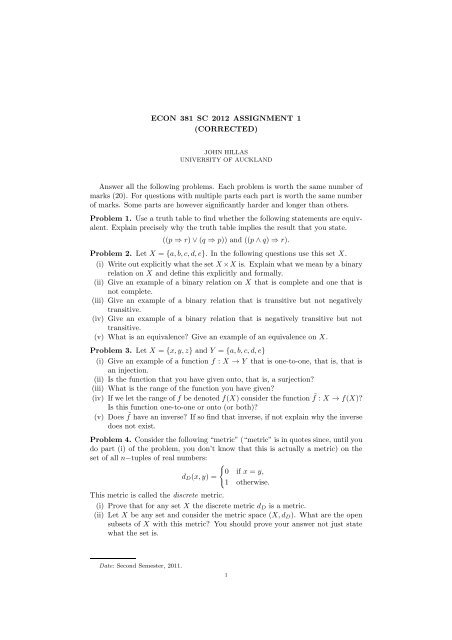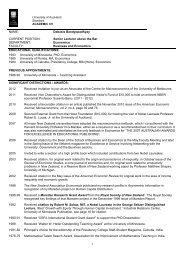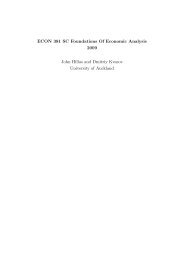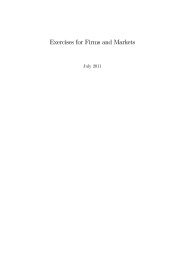ECON 381 SC 2012 ASSIGNMENT 1 (CORRECTED) Answer all the ...
ECON 381 SC 2012 ASSIGNMENT 1 (CORRECTED) Answer all the ...
ECON 381 SC 2012 ASSIGNMENT 1 (CORRECTED) Answer all the ...
Create successful ePaper yourself
Turn your PDF publications into a flip-book with our unique Google optimized e-Paper software.
<strong>ECON</strong> <strong>381</strong> <strong>SC</strong> <strong>2012</strong> <strong>ASSIGNMENT</strong> 1<br />
(<strong>CORRECTED</strong>)<br />
JOHN HILLAS<br />
UNIVERSITY OF AUCKLAND<br />
<strong>Answer</strong> <strong>all</strong> <strong>the</strong> following problems. Each problem is worth <strong>the</strong> same number of<br />
marks (20). For questions with multiple parts each part is worth <strong>the</strong> same number<br />
of marks. Some parts are however significantly harder and longer than o<strong>the</strong>rs.<br />
Problem 1. Use a truth table to find whe<strong>the</strong>r <strong>the</strong> following statements are equivalent.<br />
Explain precisely why <strong>the</strong> truth table implies <strong>the</strong> result that you state.<br />
((p ⇒ r)∨(q ⇒ p)) and ((p∧q) ⇒ r).<br />
Problem 2. Let X = {a,b,c,d,e}. In <strong>the</strong> following questions use this set X.<br />
(i) Write out explicitly what <strong>the</strong> set X×X is. Explain what we mean by a binary<br />
relation on X and define this explicitly and form<strong>all</strong>y.<br />
(ii) Give an example of a binary relation on X that is complete and one that is<br />
not complete.<br />
(iii) Give an example of a binary relation that is transitive but not negatively<br />
transitive.<br />
(iv) Give an example of a binary relation that is negatively transitive but not<br />
transitive.<br />
(v) What is an equivalence? Give an example of an equivalence on X.<br />
Problem 3. Let X = {x,y,z} and Y = {a,b,c,d,e}<br />
(i) Give an example of a function f : X → Y that is one-to-one, that is, that is<br />
an injection.<br />
(ii) Is <strong>the</strong> function that you have given onto, that is, a surjection?<br />
(iii) What is <strong>the</strong> range of <strong>the</strong> function you have given?<br />
(iv) If we let <strong>the</strong> range of f be denoted f(X) consider <strong>the</strong> function ˜f : X → f(X)?<br />
Is this function one-to-one or onto (or both)?<br />
(v) Does ˜f have an inverse? If so find that inverse, if not explain why <strong>the</strong> inverse<br />
does not exist.<br />
Problem 4. Consider <strong>the</strong> following “metric” (“metric” is in quotes since, until you<br />
do part (i) of <strong>the</strong> problem, you don’t know that this is actu<strong>all</strong>y a metric) on <strong>the</strong><br />
set of <strong>all</strong> n−tuples of real numbers:<br />
{<br />
0 if x = y,<br />
d D (x,y) =<br />
1 o<strong>the</strong>rwise.<br />
This metric is c<strong>all</strong>ed <strong>the</strong> discrete metric.<br />
(i) Prove that for any set X <strong>the</strong> discrete metric d D is a metric.<br />
(ii) Let X be any set and consider <strong>the</strong> metric space (X,d D ). What are <strong>the</strong> open<br />
subsets of X with this metric? You should prove your answer not just state<br />
what <strong>the</strong> set is.<br />
Date: Second Semester, 2011.<br />
1
2 JOHN HILLAS UNIVERSITY OF AUCKLAND<br />
Problem 5. Let (X,d) be a metric space.<br />
Ano<strong>the</strong>r approach to putting structure of a set X is to directly specify <strong>the</strong> open<br />
sets. Such a space is c<strong>all</strong>ed a topological space. If (X,τ) is a topological space <strong>the</strong>n<br />
X is a set and τ is a collection of subsets of X such that<br />
1. X ∈ τ<br />
2. ∅ ∈ τ<br />
3. If A and B are in τ <strong>the</strong>n A∩B is in τ. That is, <strong>the</strong> intersection of two elements<br />
of τ is in τ. (This also implies that <strong>the</strong> intersection of any finite number of<br />
elements of τ is in τ.)<br />
4. If A n is in τ for every n ∈ N for some set N that might be finite or infinite <strong>the</strong>n<br />
∪ n∈N A n is in τ. That is, <strong>the</strong> union of any number of elements of τ is in τ.<br />
Now let X = {a,b,c,d,e}. For <strong>the</strong> questions below use this particular set X.<br />
(i) Show that for any metric d <strong>the</strong> set of open subsets of X are <strong>the</strong> same. Find<br />
what this collection of open sets is.<br />
(ii) Show that if we let τ = {X,∅} that this collection of “open sets” satisfies <strong>the</strong><br />
four properties given above.<br />
(iii) Show that this topology cannot come from any metric. (Hint: you have<br />
essenti<strong>all</strong>y already show this in your answer to part (i).)<br />
(iv) Give ano<strong>the</strong>r set τ that satisfies <strong>the</strong> four properties given above.<br />
(v) Characterise <strong>the</strong> set of <strong>all</strong> possible topologies τ on X that satisfy <strong>the</strong> four<br />
properties.









